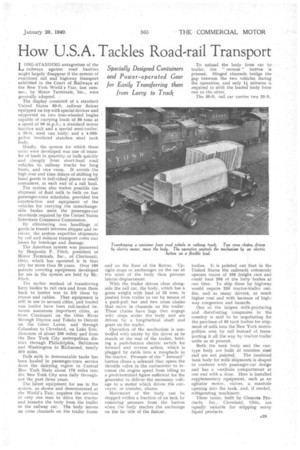How U.S.A. Tackles Road-rail Transport
Page 39

If you've noticed an error in this article please click here to report it so we can fix it.
Specially Designed Containers and Power-operated Gear for Easily Transferring them from Lorry to Truck
LONG-STANDING antagonismr of the railways against road hauliers might largely disappear if the system of combined rail and highway transport exhibited in the Court of Railways at the New York World s Fair, last sumMei , by Motor Terminals, Inc., were generally adopted.
The display consisted of a standard United States 50-ft. railway flatcar equipped on top with special devices and supported on two four-wheeled bogies capable of carrying loads of 50 tons at a speed of 90 m.p.h.; a standard motor tractive unit and a special semi-trailer; a 20-ft. steel van body; and a 4,000gallon insulated stainless steel tank body.
Briefly, the system for which these units were developed was one of transfer of loads in quantity or bulk quickly and cheaply from short-haul road vehicles to railway trucks for long hauls, and vice versa. It avoids the high cost and time delays of shifting by hand goods in individual pieces or small containers, at each end of a rail haul.
The system also makes possible the shipment of fluid milk in bulk on fast passenger-train schedules, provided the construction and equipment of the vehicles for carrying the interchangeable bodies meet the passenger-car standards required by the United States Interstate Commerce Commission.
By eliminating two handlings of goods in transit between shipper and receiver, the system expedites shipments by rail and reduces transport costs and losses by breakage and damage.
The American system was pioneered by Benjamin F. Fitch, president of Motor Terminals, Inc., of Cincinnati, Ohio, which has operated it in that city for more than 20 years. Over 160 patents covering equipment developed for use in the system are held by Mr. Fitch.
The earlier method of transferring lorry bodies to rail cars and from them back to lorries was to lift them by cranes and cables. That equipment is still in use in several cities, and loaded van bodies have been rail-hauled between numerous important cities, as -from Cincinnati on the Ohio River through Dayton and Toledo to Detroit on the Great Lakes, and through Columbus to Cleveland, on Lake Erie, distances of about 250 miles; and from the New York City metropolitan district through Philadelphia, Baltimore and Washington to Richmond, nearly 300 miles.
Bulk milk in demountable tanks has been hauled in passenger-tram service from the dairying region in Central New York State about 175 miles into the New York City area daily throughout the past three years.
The latest equipment for use in the system, as shown and demonstrated at the World's Fair, requires the services of only one man to drive the tractor and transfer the body from the trailer to the railway car. The body moves on cross channels on the trailer frame and on the floor of the flatcar. Upright stops or anchorages on the car at the sides of the body then prevent lateral displacement.
With the trailer driven close alongside the rail car, the body, which has a gross weight with load of 25 tons, is pushed from trailer to car by means of a push-pull bar and two cross chains that move in channels on the trailer. These chains have lugs that engage with stops under the body and are driven by a longitudinal shaft and gears on the trailer.
Operation of the mechanism is controlled with nicety by the driver as he stands at the rear of the trailer, holding a push-button electric switch for forward and reverse action, which is plugged by cable dnto a receptacle in the tractor. Pressure of the " forward" button closes a Solenoid that opens the throttle valve in the carburetter to increase the engine speed from idling to a predetermined figure sufficient for the generator to deliver the necessary voltage to a motor which drives the conveyor, or transfer, chains.
Movement of the body can be stopped within a fraction of an inch by removing pressure from the button when the body reaches the anchorage on the far side of the flatcar. To unload the body from car to trailer, " the " reverse " button is pressed. Hinged channels bridge the gap between the two vehicles during the operation, and only l minutes is required to shift the loaded body from one to the other.
The 50-ft, rail car carries two 20M.
bodies. It is pointed out that in the United States the railroad commonly operate trains of 100 freig t cars and could haul 200 of the lar bodies at one time. To ship these y highway would require 200 tractorltrailcr outfits, and as many driver, at much higher cost and with increase of highway congestion and hazards.
One of the largest milk-producing and distributing companies in the country is said to be negotiating for the purchase of 50 tank bodies for shipment of milk into the New York metropolitan area by rail instead: of transporting it all the way by tractor-trailer units as at present.
Both the tank body and the vantype body are built of stainless steel and are not painted. The insulated tank body for milk shipments is shaped to conform with passenger-car design and has a vestibule compartment at one end with a door. Here is installed supplementary equipment, such as an agitator motor, valves, a manhole opening into the tank, and, if needed, refrigerating machinery.
These tanks, built by GIascote Products, Inc., Cleveland, Ohio, are equally suitable for shipping many liquid products.




























































